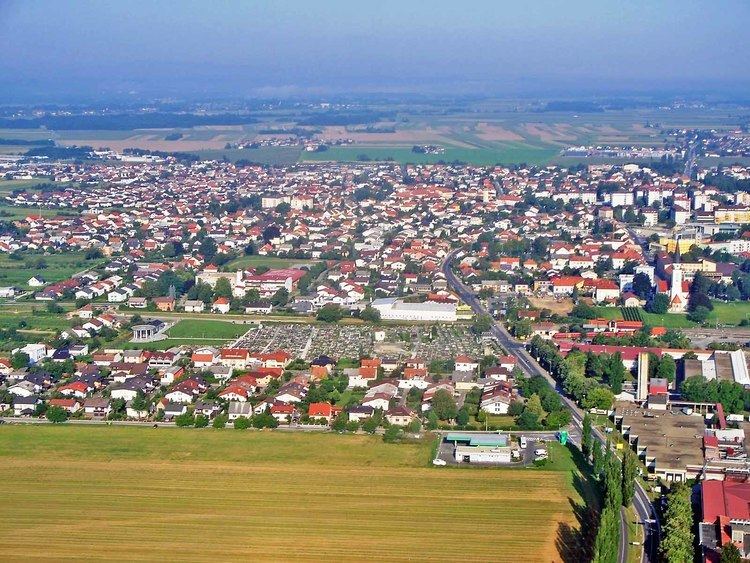Town rights around 1479 Time zone CET (UTC+01) Area 14.5 km² Local time Wednesday 3:20 AM | First mention 1348 Elevation 190 m (620 ft) Post code 9000 Population 11,679 (2010) Area code 02 | |
 | ||
Weather 9°C, Wind S at 3 km/h, 78% Humidity Clubs and Teams Rokometni klub Pomurje, NK Mura | ||
Murska Sobota ([ˈmúːɾska ˈsóːbɔta], Slovene abbreviation: MS [məˈsə̀]; German: Olsnitz; Hungarian: Muraszombat) is a city in northeastern Slovenia. It is the centre of the City Municipality of Murska Sobota near the Mura River in the region of Prekmurje and is the regional capital.
Contents
- Map of 9000 Murska Sobota Slovenia
- Name
- Features
- Jewish community of Murska Sobota
- Climate
- Twin towns Sister cities
- References
Map of 9000 Murska Sobota, Slovenia
Name
Officially, the city is known as Murska Sobota, although informally it is usually simply referred to as Sobota by its inhabitants and Murska by people from other parts of Slovenia. The traditional German name of the city is Olsnitz, which is derived from the old Slovene name Olšnica. The modern Slovene name is a translation of the Hungarian name Muraszombat, which was the official name of the city until 1919. In Hungarian, szombat means 'Saturday', referring to the city's practice of holding fairs every week on that day. Murska Sobota was a district (Hungarian: járás) city of Vas County in the Kingdom of Hungary until 1918. It was occupied by Hungary again during World War II, from 1941 to 1944. Between 1944 and 1945 it was under Nazi German occupation and it was liberated by Soviet troops in May 1945. It was also part of the Balatin Sanjak, which belonged at first to the Budin Eyalet, later the Kanije Eyaleti, before the Treaty of Karlowitz.
Features
Murska Sobota used to be Yugoslavia's northernmost city, and throughout history it has shifted across borders between Slovenia, Yugoslavia, and Hungary. Hungarians still represent a 3,000-person minority. In 1919, the Republic of Prekmurje was declared here and the city was the capital of the new state. In 1991, during the Ten-Day War between Slovenia and the Yugoslav Federal Army, Murska Sobota was bombed from the air, with no casualties or visible damage. Today, it is a quiet city with an economy based on regional administration, light industry, commerce, and spa tourism. In April 2006, the city became the see of the newly created Roman Catholic Diocese of Murska Sobota, which is a suffragan to the archdiocese of Maribor.
Jewish community of Murska Sobota
The once significant Jewish community of Murska Sobota was eliminated by Nazi Germany. Before the World War II, a synagogue built by Lipót Baumhorn stood in Murska Sobota. It was consecrated on 31 August 1908 and demolished in 1954 by the local communist authorities after they purchased the building from a decimated Jewish community. The last rabbi in Murska Sobota was Lazar Roth. He was murdered at Auschwitz.
On 26 April 1944, all of the Jews were ordered to gather in the Murska Sobota synagogue, with hand luggage only. There, they were locked up overnight without food or water, and the next morning all the Jews of Murska Sobota were transferred to Čakovec and then to Nagykanizsa, the main concentration camp before their final destination of Auschwitz.
On 29 January 2010, the first Holocaust memorial in Slovenia was unveiled at the Murska Sobota railway station. It is dedicated to the exile of Jews from the Prekmurje region.
Climate
Annual rainfall in Murska Sobota is among the lowest in Slovenia. Characterized by the instability of rainfall, severe droughts are frequent.
Twin towns — Sister cities
Murska Sobota is twinned with:
